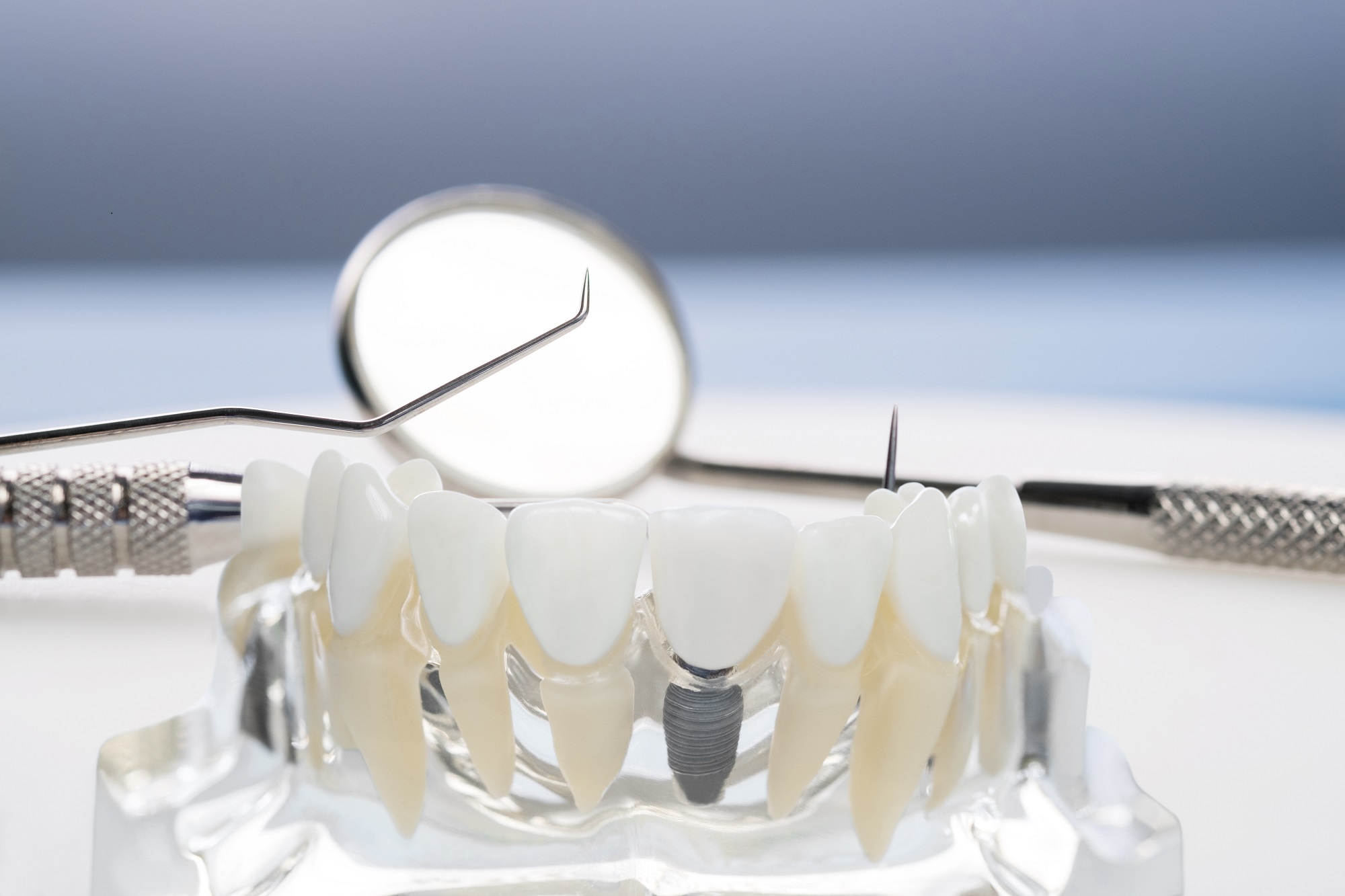
Our Prosthodontics and Implant services focus on restoring the function, comfort, and appearance of your teeth through a range of fixed and removable solutions. We provide personalized treatment options using the latest techniques to help you regain your smile with confidence.
At Tooth Buddies, our Prosthodontics and Implant Dentistry services are dedicated to restoring missing, damaged, or decayed teeth using advanced prosthetic techniques and state-of-the-art technology. We offer a wide range of solutions—from simple crowns and bridges to complex implant-supported restorations and full-mouth rehabilitation. Whether it’s a single missing tooth or a complete set, we provide customized treatment plans tailored to the patient’s needs, lifestyle, and aesthetics. Our offerings include fixed and removable options such as complete dentures, overdentures, cast partials, and implant-supported hybrid dentures. For patients with special needs, such as oral cancer survivors, we also provide obturator prostheses to help restore function and appearance. With a strong focus on precision, comfort, and natural-looking outcomes, our prosthodontic care helps patients chew better, speak clearly, and smile confidently again.
Crowns are used to cover and protect damaged teeth, while bridges replace one or more missing teeth by anchoring onto adjacent teeth. They restore chewing function and improve aesthetics using natural-looking materials like ceramic or zirconia. Crowns and bridges are durable, long-lasting, and custom-made for each patient.
This technique is used when a tooth is severely decayed or fractured but still salvageable. A post is placed inside the root canal, and a core buildup is done to support the crown. It reinforces the tooth structure and provides stability for crown placement. This is a common solution after root canal treatments.
Dental implants are titanium posts surgically placed into the jawbone to replace missing tooth roots. A crown is then placed over the implant to restore appearance and function. Implants look, feel, and function like natural teeth and are a long-term solution for tooth loss. They help preserve jawbone and facial structure.
Complete dentures are removable appliances used when all teeth are missing in the upper or lower arch. They restore the ability to chew, speak, and smile confidently. Custom-designed to fit comfortably, these dentures improve facial aesthetics and can significantly enhance quality of life for edentulous patients.
These are fixed dentures anchored to dental implants, offering greater stability than traditional dentures. They are ideal for patients seeking a secure, comfortable alternative to removable dentures. Hybrid dentures restore natural chewing ability and prevent bone loss, enhancing both oral function and facial structure.
For patients who have undergone maxillofacial surgery due to oral cancer, obturator prostheses help close defects in the palate. This allows for improved speech, swallowing, and aesthetics. Custom-designed for each patient, these prosthetics play a vital role in functional rehabilitation and emotional recovery.
Overdentures are removable dentures that fit over remaining natural teeth or implants. They provide better retention and stability compared to conventional dentures. Preserving underlying bone and providing improved chewing efficiency, overdentures are a comfortable and practical solution for many adults.
Cast partial dentures replace missing teeth using a metal framework for strength and support. These removable dentures attach securely to the natural teeth with precision clasps. They are less bulky, more durable, and offer better fit and comfort than acrylic partial dentures.
A dental implant is a structure that replaces a missing tooth. With screw-like devices, the surgeon inserts an implant into the jawbone, and it acts as an anchor for an artificial tooth, called a crown.
A device called an abutment connects the artificial tooth to the dental implant.
The crown is custom-made to fit the person’s mouth and match the colour of their teeth. Crowns look, feel, and function like natural teeth.
Implants have several advantages over dentures, which are removable artificial teeth. Implants are:
• are more natural and comfortable
• have a higher success rate
• improve chewing function
• lead to a lower risk of cavities developing in nearby teeth
• lead to better maintenance of bone at the site of the lost tooth
• cause decreased sensitivity in nearby teeth
• do not need to be taken out and cleaned every night
However, dental implants are not suitable for everyone. The implanting devices must bond with the jawbone, so a person’s bones must be healthy before they can undergo implant surgery.
Some people are not eligible for dental implant surgery. It not safe for dental surgeons to operate on people with:
• acute illness
• uncontrollable metabolic disease
• bone or soft tissue disease or infection
If these issues are resolved, a person can have the surgery.
In some cases, dental surgeons refrain from operating on people with:
• heavy smoking habits
• parafunctional habits, such as tooth grinding or clenching
• behavioral or psychiatric disorders
• HIV
• diabetes
• osteoporosis
• AIDS
If people with any of the above undergo dental implant surgery, there is a higher risk of the implant failing.
Dental surgeons may also choose not to operate on people undergoing the following treatmentss, due to an increased risk of implant complications:
• bisphosphonate drug treatment for bone loss diseases
• chemotherapy
• radiation therapy of the head or neck
Each person is likely to have a different experience of dental implant surgery. Factors that may influence this include:
• the number of teeth requiring replacement
• the location of the implants within the jaw
• the quality and quantity of bone at the implant site
• the person’s underlying oral and systemic health
• Depending on these factors, additional procedures may be necessary. These can include:
• Placing an implant in the upper jawbone is usually difficult because of the location of the sinuses.
• The surgeon may need to perform a sinus augmentation — a procedure to lift the floor of the sinuses to allow more bone to develop so that the implantation can be successful.
• Some people have a jawbone abnormality that prevents enough bone for an implant from developing. In such cases, a surgeon may need to perform a ridge modification.
• This involves lifting the gum to expose the area of deformed bone. The surgeon will then use a bone or bone substitute to repair and build up the area. This improves the quality of the jawbone in preparation for dental implant surgery.
• After a person has undergone dental implant surgery, they must continue to brush and floss their teeth regularly. Artificial teeth require the same care and maintenance as regular teeth.
• The surgeon or dentist will also schedule follow-up visits to monitor the implants and make sure that the teeth and gums are healthy. It is important to return to the dentist every 6 months for professional cleanings.
Dental implants may provide longer-term benefits if a person takes care of them well.
single tooth implant-
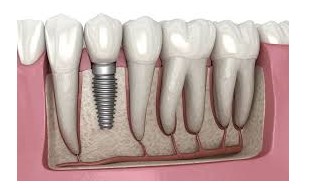
Implant supported dentures-
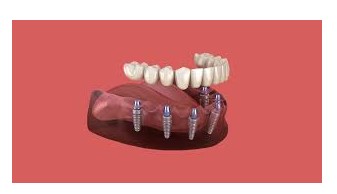
Dental veneers are thin covers that adhere to teeth to give teeth a more classically shaped look.
If you want to improve your smile, dental veneers are a simple option. Veneers are thin coverings that are placed over the front (visible) part of the tooth. They look like natural teeth. Veneers can be used to correct a wide range of dental issues, such as:
• teeth that are stained and can’t be whitened by bleaching
• chipped or worn teeth
• crooked or misshapen teeth
A porcelain veneer is a thin shell that is custom-made to fit on the tooth. Benefits of porcelain veneers:
• they are strong and long-lasting
• they have a natural-looking surface
• less tooth enamel needs to be removed than with a crown or cap
• they don’t stain easily
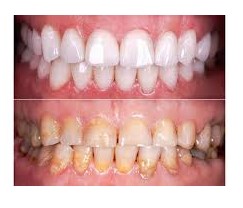
A composite resin veneer is made from a tooth-colored filling material bonded to the tooth.
Benefits of composite resin veneers:
• usually less tooth enamel needs to be removed than for crowns or porcelain veneers
• may mean fewer visits to the dentist—sometimes these veneers take just one visit
• cost less than porcelain veneers
• are easy to fix if they get damaged; although composite veneers are generally not as strong or wear-resistant as porcelain veneers, composite veneers can be repaired easily and quickly
• Your teeth and gums must be healthy before you get veneers. Your dentist can treat any disease or decay before your veneers are placed.
• Veneers are not always a good choice for patients who clench or grind their teeth, because the thin veneers may chip or break. If you clench or grind your teeth, your dentist may suggest you wear a plastic dental night guard while sleeping.
• Although your dentist removes as little tooth enamel as possible for veneers,
the process cannot be undone once the enamel is removed.
• It is possible for veneers to come loose over time. In that case, new ones might be needed.
Resin infiltration technique is a novel technology that bridges the gap between prevention and restoration of early decay and can camouflage aesthetically disfiguring white spots and fluorosis stains.
This type of minimal intervention technology has the following advantages:
• Noninvasive treatment, preserving tooth structure;
• Achieved in a single visit;
• Mechanical stabilization of demineralized enamel;
• Deeper penetration into porous demineralized areas;
• Arrest/retardation of lesion progress;
• Minimized risk of secondary decay
• No risk of postoperative sensitivity and pulpal inflammation;
• Reduced risk of gum and bone disease
• Improved esthetic outcome when used as a “masking” resin on demineralized labial surfaces (white spot lesions, i.e. with orthodontic patients);
• High patient acceptance
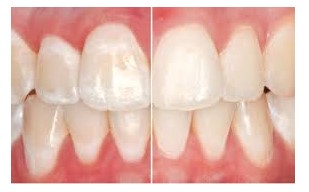
Tooth bleaching is the most common procedure in cosmetic dentistry. Bleaching of teeth is one of the most conservative and cost-effective dental treatments for discoloured teeth than aggressive methods like veneering, crowning or bonding to enhance an individual smile.
It is ideal for people who have healthy and unrestored teeth and gums. Tooth whitening cannot make a complete colour change but it may lighten the existing shade and is not permanent.
Teeth get discoloured due to unhealthy habits, poor dental hygiene, medications, and other factors. Tooth discolouration can be classified into extrinsic discolouration and intrinsic discolouration.
Extrinsic discolouration occurs when stains affect the tooth’s surface or enamel. Extrinsic discolouration occurs due to:
1. Certains foods
2. Smoking and tobacco products
3. Drinks like coffee and tea
Intrinsic discolouration is when the stain is inside the tooth. Reasons for intrinsic discolouration include:
1. Genetics
2. Trauma
3. Tooth decay
4. Fluorosis
5. Certain kinds of medications
Besides intrinsic and extrinsic discolouration, teeth can also become yellow due to advancing age.
Turning your teeth from yellow to white will take around three or four weeks.
Currently, bleaching agents which are used are based primarily on either hydrogen peroxide or carbamide peroxide. The peroxide oxidizing agent penetrates the porosities in the rod-like crystal structure of enamel and breaks down the stain.
Yellowish teeth respond well to bleaching compared to brownish-coloured teeth. Gray/purple or tetracycline stains are more difficult to lighten and may require prolonged bleaching. The effect is less likely to last as long if you smoke, eat or drink products that stain your teeth.
Teeth can turn yellow or become discoloured for a number of different reasons. Though age is a significant reason - smoking, certain foods, coffee, tea, antibiotics, etc, can also cause teeth to turn yellow. However, bleaching is a great way to turn stained and yellow teeth into sparkling white again.
Teeth bleaching is a part of cosmetic surgery and a process wherein the dentist will brighten the colour of your teeth by removing traces of discolouration. There are two ways to undergo tooth bleaching - home bleaching and in-clinic bleaching (In-office bleaching).
A doctor performs in-office bleaching in a clinic with the aid of medical infrastructure.
Home bleaching can be done at home using trays made by the doctor or other methods.
In general, both techniques have been shown to be effective, although, the results may vary depending on such factors as the type of stains, age of the patient, the concentration of bleaching agent, treatment time and frequency.
In-office bleaching contains from 15% to 43% peroxide and at-home bleaching contains from 3% to 20% peroxide.
Teeth whitening is done by a dental professional. The bleaching agent is much stronger than home bleaching. Light, heat or a combination of two may be used to intensify the whitening process. Bleaching can be done in approx 30 min to 1 hr in a single visit.
Example – Zoom bleaching [most widely used bleaching process which uses the zoom advanced power chairside lamp to accelerate the bleaching process].
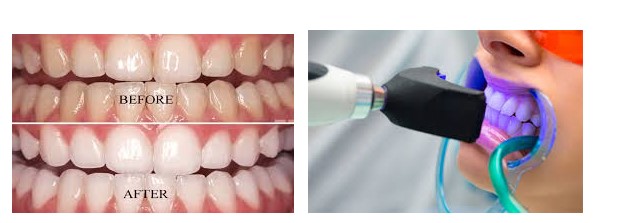
These are available over the counter or supplied by a dental professional. Teeth whitening can be done by whitening toothpaste [mildly abrasive and does not alter the intrinsic colour of teeth], rinses, strips and gels, and tray-based tooth bleaching [tray is filled with bleaching gel and placed over the teeth]. They are less expensive.
With suitable techniques and products, teeth bleaching can be easily done at home. Some bleaching options include:
You can apply a whitening gel to your teeth with a brush. A whitening strip is a very thin strip that comprises peroxide-based whitening gel. Before applying any of these products, read the descriptions and directions carefully. It will help you understand how to use them.
Tray-based tooth bleaching system is a kind of mouth guard that comprises a gel whitening solution. Wearing the mouthguard for a few hours during the day and night will provide you with sparkling white teeth. Your dentist will suggest the duration for which the tray-based tooth whitening system should be used.
Stains on the teeth can occur due to drinking tea or coffee. A tooth whitening toothpaste is very effective in removing these stains.
Most people do not have any side effects of teeth whitening. However, some people may encounter some side effects like:
This is a common issue and usually occurs in patients with weak enamel. Sometimes improper application of the whitening can also lead to sensitivity. To avoid this issue, get teeth whitening done at a clinic by an experienced doctor.
When whitening teeth, the gum needs to be isolated. If this is not done, it will lead to irritation.
1. Allergy to peroxide
2. Pregnant or lactating women
3. Sensitive teeth
4. Gingival Recession {receding gums}
5. Children under the age of 16
6. Caries and defective dental filling. Tooth-coloured fillings, crowns, and veneers do get whitened.
Tooth bleaching is best performed under dental professional supervision and following a pretreatment dental examination and diagnosis. Several companies have started advertising their bleaching products directly to patients with no dentist involvement.We do not advise such treatments which are not evidence based.
The most appropriate bleaching treatment options may be selected according to the patient’s lifestyle, financial consideration and oral health. Success will vary when tooth discolouration is related to developmental aspects, extrinsic [smoking, diet] or intrinsic stains [tetracycline], age-related tooth changes or colour changes secondary to teeth trauma.
Tooth Buddies delivers quality dentistry with a personalized touch. Each patient is treated with the utmost care, compassion, empathy.
Copyright © 2025 All Rights Reserved.